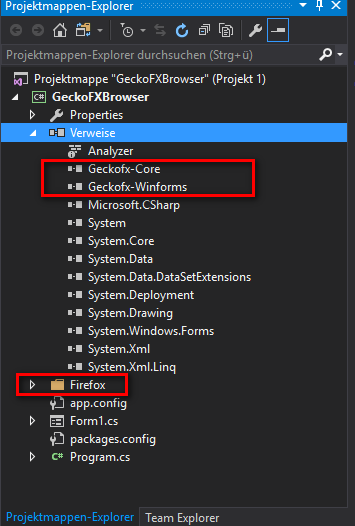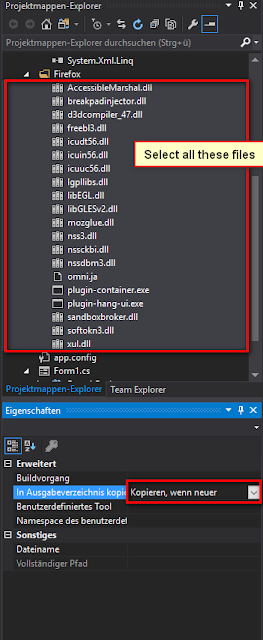Have you ever heard of WebBrowser in .NET Application? If yes, then you know how bad is the Default WebBrowser in .NET. In Internet we can find many alternative for the .NET's Default WebBrowser. There are many, such as CefSharp or GeckoFX,....
In this post I will introduce to you GeckoFX and I will show you how to build your first Gecko Browser program with the Blocking Feature.
GeckoFX is the open source component to embedding the Gecko rendering engine from Mozilla Firefox to .NET application.
To download GeckoFX-Source (current version is GeckoFX-45) go to the GeckoFX BitBucket Wikipage https://bitbucket.org/geckofx/geckofx-45.0/wiki/Home
Or we can use "NuGet-Package Manager" to install GeckoFX-45 to your project as the picture below:
After that we'll see the Firefox folder and the 2 new Dependencies in the Project Explorer Window:
First we have to declare Gecko namespace
Just one more setting, select all files from the Firefox folder and select "Always copy" or "Copy when newer" to "Output folder" as below:
Now we can use the GeckoWebbrowser. Just declare the GeckoWebBrowser variable and load all the needed dll files as the picture below:
What is function InitBrowser? It a function to configure the WebBrowser and to add the Browser into the Form
The important Thing to use Blocking feature of GeckoFX is we have to enable HttpActivityObserver, so we set here UseHttpActivityObserver = true.
After UseHttpActivityObserver is enabled, we need to add a Event-Handler, in this case is ObserveHttpModifyRequest-Event from GeckoWebBrowser.
When the WebBrowser send any request to any URL the event ObserveHttpModifyRequest will be fired. We can get the URL of the request by using variable request and convert it to string with request.Uri.ToString(). In this example, I block all the Request that contain "google.com" in the URL.
Here is the code:
P/S: In this tutorial I installed and use GeckoFX-45 32 bit, so when build the project I have to choose x32 Platform (It will give error when you try to compile to 64 bit Application, in case you want to build 64 bit Application, just install GeckoFx45.64 in the NuGet-Package Manager)
In this post I will introduce to you GeckoFX and I will show you how to build your first Gecko Browser program with the Blocking Feature.
GeckoFX is the open source component to embedding the Gecko rendering engine from Mozilla Firefox to .NET application.
To download GeckoFX-Source (current version is GeckoFX-45) go to the GeckoFX BitBucket Wikipage https://bitbucket.org/geckofx/geckofx-45.0/wiki/Home
Or we can use "NuGet-Package Manager" to install GeckoFX-45 to your project as the picture below:
After that we'll see the Firefox folder and the 2 new Dependencies in the Project Explorer Window:
First we have to declare Gecko namespace
using Gecko;
Just one more setting, select all files from the Firefox folder and select "Always copy" or "Copy when newer" to "Output folder" as below:
Now we can use the GeckoWebbrowser. Just declare the GeckoWebBrowser variable and load all the needed dll files as the picture below:
What is function InitBrowser? It a function to configure the WebBrowser and to add the Browser into the Form
The important Thing to use Blocking feature of GeckoFX is we have to enable HttpActivityObserver, so we set here UseHttpActivityObserver = true.
After UseHttpActivityObserver is enabled, we need to add a Event-Handler, in this case is ObserveHttpModifyRequest-Event from GeckoWebBrowser.
When the WebBrowser send any request to any URL the event ObserveHttpModifyRequest will be fired. We can get the URL of the request by using variable request and convert it to string with request.Uri.ToString(). In this example, I block all the Request that contain "google.com" in the URL.
Here is the code:
public GeckoWebBrowser webBrowser;When you have any question, feel free to leave a commend, I will answer as soon as I can. Have fun coding!
public Form1()
{
InitializeComponent();
Xpcom.Initialize("Firefox"); // Init all Gecko DLL files in the Firefox folder inside the Project
InitBrowser();
}
// Init Browser
void InitBrowser()
{
webBrowser = new GeckoWebBrowser { Dock = DockStyle.Fill, // Fill all the Form
UseHttpActivityObserver = true // This is to enable HttpActivityObserver
};
webBrowser.ObserveHttpModifyRequest += (obj, request) => {
if (!request.Uri.ToString().Contains("google.com")) // if the request URL contains string "google.com"
{
request.Cancel = true; // Cancel the request to the URL
}
};
this.Controls.Add(webBrowser);
}
P/S: In this tutorial I installed and use GeckoFX-45 32 bit, so when build the project I have to choose x32 Platform (It will give error when you try to compile to 64 bit Application, in case you want to build 64 bit Application, just install GeckoFx45.64 in the NuGet-Package Manager)









